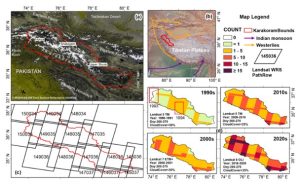
Despite their extreme elevation, glaciers on the Tibetan Plateau are losing mass in response to atmospheric warming, the pattern of which purportedly reflects regional contrasts in climate. Here we examine the evolution of glaciers along ∼500 km of the Tanggula Shan, CentralEastern Tibetan Plateau. Using remotely sensed datasets, we quantified changes in glacier mass, area and surface velocity, and compared these results to time series of meteorological observations, in order to disentangle drivers of glacier mass loss since the 1960s. Glacier mass loss has increased (from −0.21 ± 0.12 m w.e. a−1 in 1960s–2000s, to −0.52 ± 0.18 m w.e. a−1 in 2000s2015/18) in association with pervasive positive temperature anomalies (up to 1.85°C), which are pronounced at the end of the now lengthened ablation season. However, glacier mass budget perturbations do not mirror the magnitude of temperature anomalies in sub-regions, thus additional factors have heightened glacier recession. We show how proglacial lake expansion and glacier surging have compounded glacier recession over decadal/multi-decadal time periods, and exert similar influence on glacier mass budgets as temperature changes. Our results demonstrate the importance of ice loss mechanisms not often incorporated into broad-scale glacier projections, which need to be better considered to refine future glacier runoff estimates.
Reference: King, O., Ghuffar, S., Bhattacharya, A., Yao, R., Yao, T., & Bolch, T. (2023). Glaciological and climatological drivers of heterogeneous glacier mass loss in the Tanggula Shan (Central-Eastern Tibetan Plateau), since the 1960s. Journal of Glaciology, 1–18. https://doi.org/10.1017/jog.2023.5



